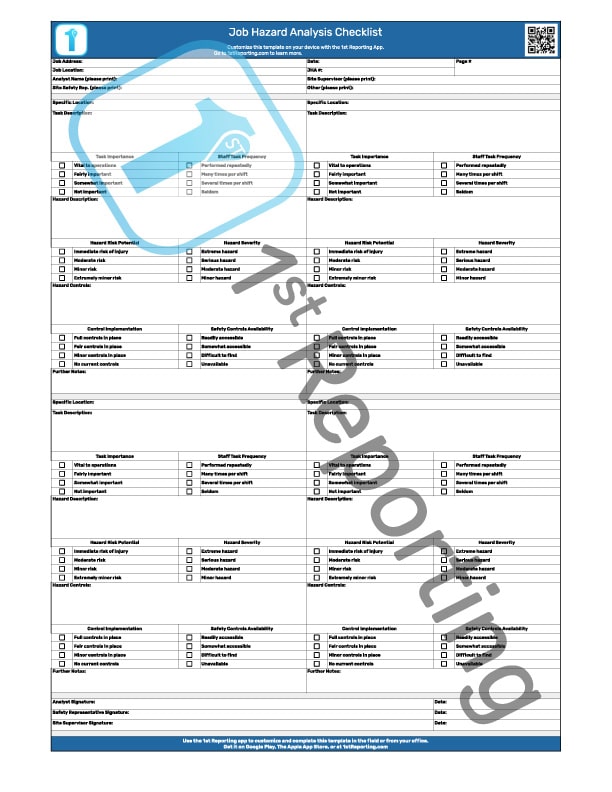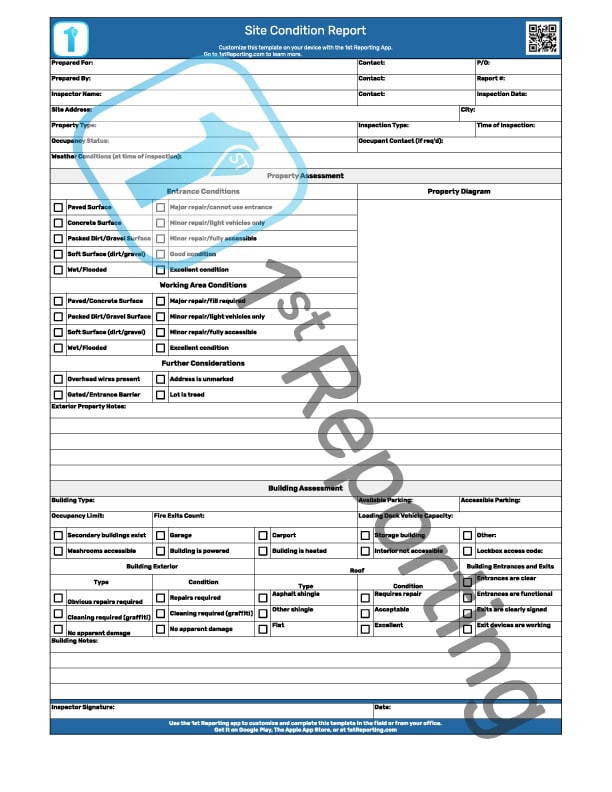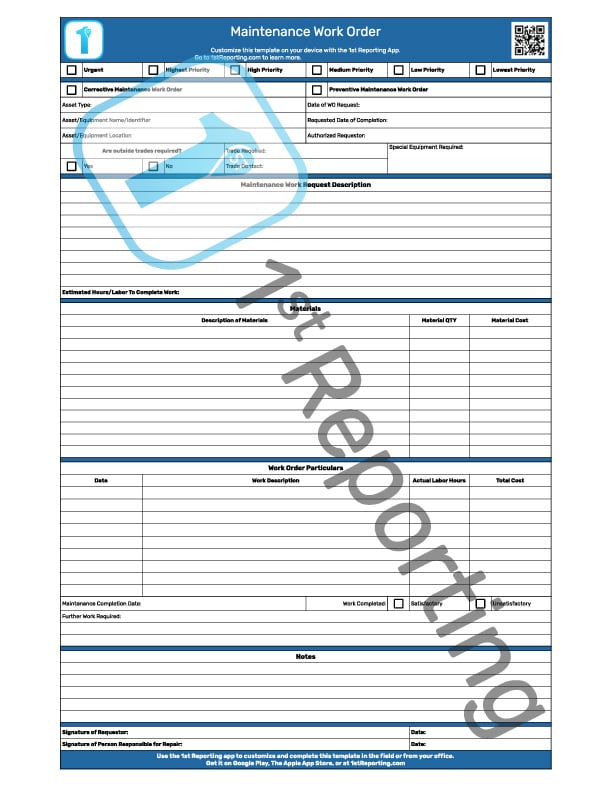Confined space entry permits require a systematic approach to document management. In any situation where life is quite literally at risk, it’s wise to implement strict safety policies, including using a standardized Confined Space Permit Template.
The Confined Space Permit Form is a document a responsible individual completes to communicate job-specific safety information to everyone involved. It aids in maintaining safety requirements and regulatory compliance.
Our Confined Space Permit Template is part of a series of safety-related documents available in our template library and on our industry reporting platform, 1st Reporting. This article will review the confined space permit document, the best practices for using it, and tips for safer and more efficient operations. Let’s get started.
Included in the Confined Space Permit Form
Your organization’s assets must comply with regulations as representatives of your company. Furthermore, and more importantly, regulatory compliance means safe working practices; when it comes to work involving confined spaces, it’s serious business. Therefore, getting the correct information is crucial to ensure the utmost safety and compliance so everyone can go home happy at the end of the day.
Six sections compound to create our confined space permit form. The information on the form is based on available OSHA and is necessary to ensure the safety of those involved.
Here is a brief tutorial on the intent of each section you’ll find on the Confined Space Permit Template:
Entry Administrative Information
Vital information regarding the confined space entry request is recorded within the entry administrative information section of the form. This information helps to maintain organization and understanding of the event at a glance. Similarly, it enables you to easily control data information and organization via the various fields presenting critical information for the confined space entry event.
Hazard Communications
Maintaining communication with their attendants is of the utmost importance when a person enters a confined space. Critical information must find its way from one to another in seconds. A communication stall can mean the difference between life and death. Due to its critical nature, we’ve included a communication segment to the permit so no one is left wondering.
Confined Space Special Requirements
Every situation is different, and some circumstances call for special requirements. Confined space entry requires a specific set of safety equipment. Furthermore, specific operational conditions might provide exclusive challenges one must overcome to complete the confined space entry safely. The special requirements segment of the form intends to provide a means to communicate those unique requirements.
Pre-Entry Safety Testing
Depending on the conditions, confined spaces can accumulate dangerous gases and vapors. Due to the nature of gases like carbon monoxide, we’re all aware of the consequences of ignorance – especially when a gas can be invisible and odorless. Therefore, the only safe course of action is preliminary testing of the atmospheric conditions within a confined space before human entry. In simple terms, test before you go in to ensure it’s safe. Record the findings on this segment of the form.
Authorized Entrants and Attendants
Supervisors should approve authorized entrants and attendants based on their experience and safety training. A supervisor should never send an untrained person into a confined space, nor should an untrained person enter a confined space before proper training. This section of the CSP form includes spaces to record the names of all personnel entering or attending the confined space event.
Notes and Sign-Off
Most inspection, incident, or situational reports require a signature following the completion of the event. In situations like fire watch and confined space, it’s more than just a standard practice; it’s crucial for safety. Lives depend on following the proper procedures to the letter. For this reason, we’ve included both a brief notes section to convey other pertinent information and two signature fields.
One field is for the lead person entering the confined space, and the other is for the supervisor attending the event. This method maintains a higher standard of control, being that two individuals must agree with the information on the permit and sign off on it.
How To Use The Confined Space Permit Template
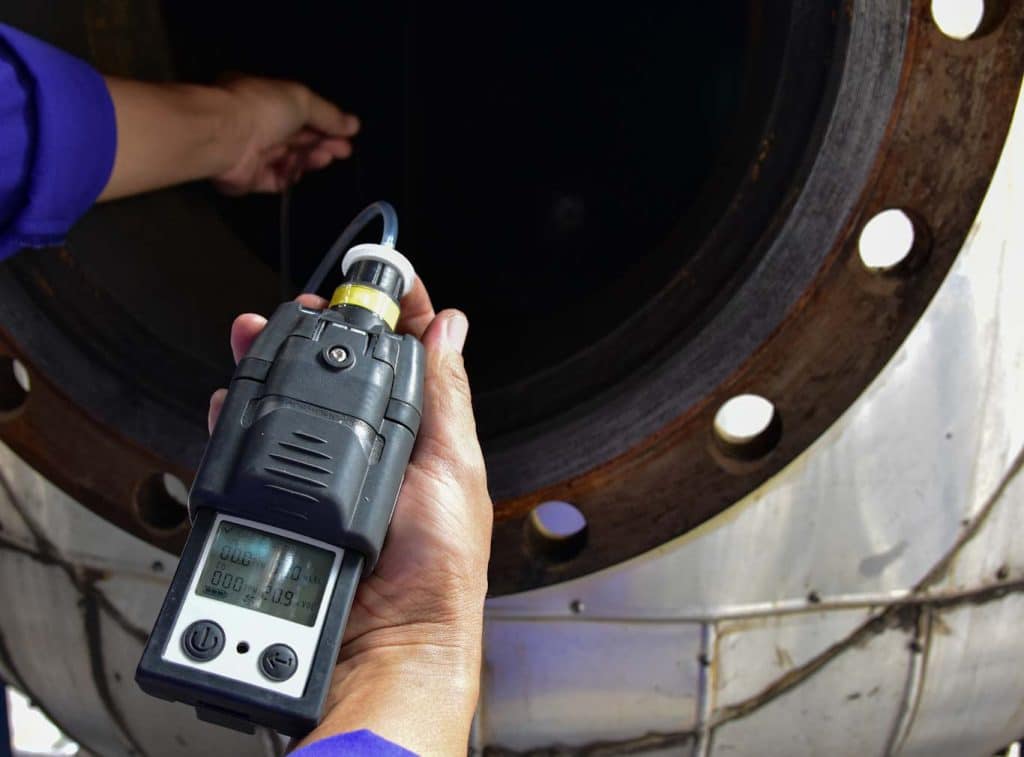
To get started with our template, you have options. First, you can download our version of the confined space permit and print it for use. Distribute it to your team and find a place to store completed forms for the required time. If you prefer a more efficient option, try our app, 1st Reporting, instead. Either way, the form needs to be incorporated into a confined space entry procedure to be used appropriately.
Your Confined Space Entry Procedure, or CSEP, should be part of your Health and Safety Manual. Similarly, you may want to include the procedure along with your Job Hazard Analysis and other safety forms in your company safety form book.
To know what to include, it’s a good idea to do two things: Confirm what the national legislation stipulates about the nature of your work. Second, ensure you and your team have the appropriate training and certification to complete the tasks safely. That means following a procedure for entry and exit to the confined space.
According to OSHA, there are 11 crucial steps needed to safely enter, work in, and exit a confined space. We’ve distilled the bulk into their fundamental points:
- Consult with the confined space supervisor to request a confined space permit.
- Complete the confined space permit pre-job information, consult again with the confined space supervisor, and discuss the project with any attendants or other relevant team members.
- Confirm all protective meters have recent and appropriate calibration. Ensure all are in proper working condition.
- Confirm all PPE and rescue equipment is fully operational and ready to use.
- Perform a pre-entry check to ensure that all safety measures are in place. Then, perform a pre-entry atmospheric test using the appropriate meters. Note the results and proceed accordingly.
- As per regulations, all entering the confined space should confirm their personal meters are fully operational.
- Complete a Job Hazard Analysis and begin entry to the confined space if safe.
- Attendants maintain constant communication with those entering the confined space.
- Attendants contact the confined space supervisor upon exiting any who entered the confined space.
- Complete the confined space permit and submit it to the confined space supervisor.
Consider that every situation is different and complex. Therefore, our list is just a baseline, and you will likely need to add some points, depending on your situation. Please review and comply with any local legal requirements for confined space entry. And above all, stay safe.
7 Tips To Keep Your Confined Space Procedures On Track
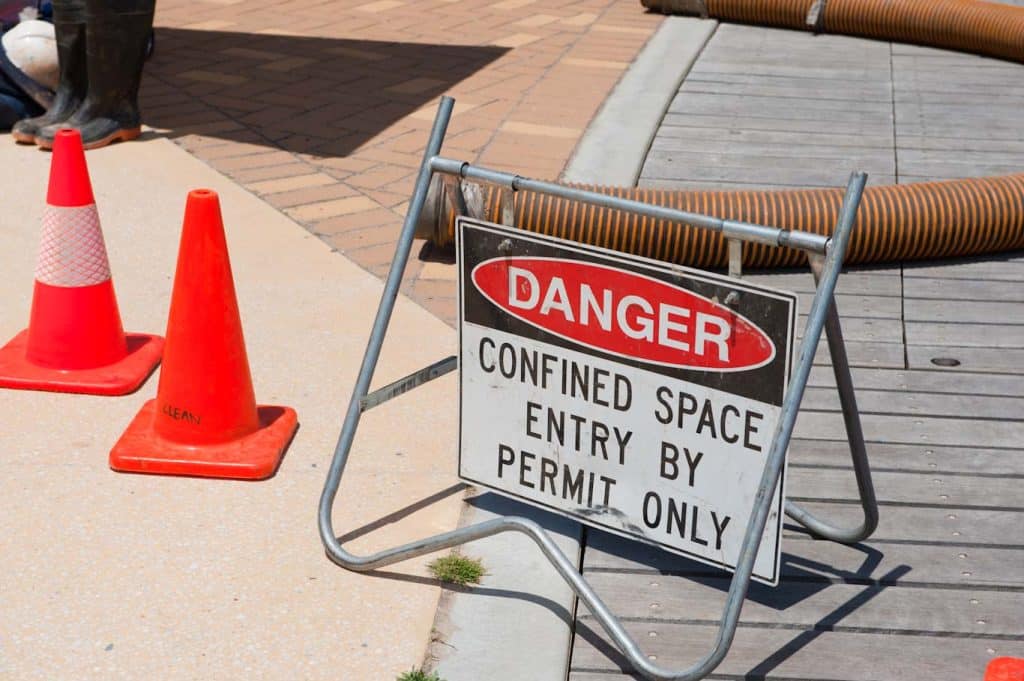
Develop A Standardized Confined Space Entry Procedure
Developing a standardized confined entry procedure for your workplace is crucial to safe operations. Furthermore, it enables multiple individuals to learn a specific safety protocol, allowing easier attendance and more excellent safety. There’s safety in numbers, after all.
Mandate Mandatory Pre-Entry Meetings
Ensure that a pre-entry meeting occurs that conveys the following:
- Entry hazards and precautions – Everyone must know the specific dangers and risks of the confined space.
- Safety evacuation/rescue procedures – Ensure all involved know what to do in an emergency.
- Entry and exit procedures – Ensure all involved understand the processes and their role and responsibilities.
- Communication standards – Critical to entrants and attendees, it is vital that these parties discuss how they will communicate once the entrant is inside the confined space.
Never Skip Pre-Entry Testing
It is essential to check the air in a confined space before entering it. This checking is called pre-testing, and it helps ensure that the area is safe for people to work in. Pre-testing ensures that the air does not contain anything dangerous, like too much dust or gases like carbon monoxide.
Triple-Check All Safety And Rescue Equipment
Before entering a confined space, it is essential to check the health and safety equipment three times. It helps ensure that everyone working in the confined space is safe and that any rescue equipment is ready to use.
Implement Proper Training And Refresher Training Programs
Team members must learn health and safety standards when working in a confined space. Everyone involved must complete training on how to stay safe and its importance.
Good training also includes implementing a scheduled refresher course for workers involved in hazardous activities like working in confined spaces. This helps ensure that everyone knows how to stay safe and offers opportunities to introduce improvements to procedure and safety.
Maintain Strict Access/Entry Policies
Although it might not be obvious, strict rules for entering a small space are crucial. They help ensure everyone stays safe and healthy. Strict and standardized rules can help people know what to do in an emergency and how to communicate with each other inside the space. Rules also help track who is allowed in the space and who isn’t.
Perform Procedural Follow-Up Assessments To Look For Ways To Improve Safety
Once you implement a procedure for confined spaces, you should not stop working on safety. Instead, it would be best to perform a follow-up assessment to ensure the processes are sufficient and improved.
Empower Your Teams With A Mobile Reporting Experience
It is vital to ensure everyone working in a confined space under your supervision knows how to stay safe. Empowering team members with mobile reporting allows them to record health and safety information quickly and easily, helping keep everyone safe when doing inspections or documenting their work.
The benefits of a mobile safety application designed for your industry far outweigh the use of a paper form. Imagine managing your field teams and in-house technicians with a robust report dashboard that conveys (via GPS) the locations where each report submission took place. So, it’s easier than ever to manage your teams.
Implement the app and provide your teams with procedures, checklists, reports, and forms to accompany their workday. You’ll have a complete management system in one place.
Furthermore, its integration capabilities with Microsoft Teams® means that you don’t even need to close Teams® to receive notifications of report completion in the field.
Need a custom report or form that isn’t in our robust Template Library? No problem. Our app comes with a built-in form builder. You’ll be able to make all the custom forms your organization needs and deploy them to your teams accordingly.
Ready to see for yourself? Talk to us about implementing the app into your business.



